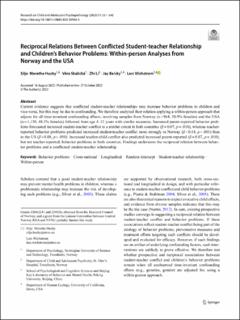| dc.contributor.author | Husby, Silje M. | |
| dc.contributor.author | Skalicka, Vera | |
| dc.contributor.author | Li, Zhi | |
| dc.contributor.author | Belsky, Jay | |
| dc.contributor.author | Wichstrøm, Lars | |
| dc.date.accessioned | 2023-04-25T11:39:09Z | |
| dc.date.available | 2023-04-25T11:39:09Z | |
| dc.date.created | 2022-11-15T13:04:30Z | |
| dc.date.issued | 2023 | |
| dc.identifier.citation | Research on Child and Adolescent Psychopathology. 2022, . | en_US |
| dc.identifier.issn | 2730-7166 | |
| dc.identifier.uri | https://hdl.handle.net/11250/3064932 | |
| dc.description.abstract | Current evidence suggests that conflicted student-teacher relationships may increase behavior problems in children and vice-versa, but this may be due to confounding. We therefore analyzed their relation applying a within-person approach that adjusts for all time-invariant confounding effects, involving samples from Norway (n = 964, 50.9% females) and the USA (n = 1,150, 48.3% females) followed from age 4–12 years with similar measures. Increased parent-reported behavior problems forecasted increased student-teacher conflict to a similar extent in both countries (β = 0.07, p = .010), whereas teacher-reported behavior problems predicted increased student-teacher conflict more strongly in Norway (β = 0.14, p = .001) than in the US (β = 0.08, p = .050). Increased teacher-child conflict also predicted increased parent-reported (β = 0.07, p = .010), but not teacher-reported, behavior problems in both countries. Findings underscore the reciprocal relation between behavior problems and a conflictual student-teacher relationship. | en_US |
| dc.language.iso | eng | en_US |
| dc.publisher | Springer Nature | en_US |
| dc.rights | Navngivelse 4.0 Internasjonal | * |
| dc.rights.uri | http://creativecommons.org/licenses/by/4.0/deed.no | * |
| dc.title | Reciprocal Relations Between Conflicted Student-teacher Relationship and Children’s Behavior Problems: Within-person Analyses from Norway and the USA | en_US |
| dc.title.alternative | Reciprocal Relations Between Conflicted Student-teacher Relationship and Children’s Behavior Problems: Within-person Analyses from Norway and the USA | en_US |
| dc.type | Peer reviewed | en_US |
| dc.type | Journal article | en_US |
| dc.description.version | publishedVersion | en_US |
| dc.source.pagenumber | 331–342 | en_US |
| dc.source.volume | 51 | en_US |
| dc.source.journal | Research on Child and Adolescent Psychopathology | en_US |
| dc.identifier.doi | 10.1007/s10802-022-00968-4 | |
| dc.identifier.cristin | 2074198 | |
| cristin.ispublished | true | |
| cristin.fulltext | original | |
| cristin.qualitycode | 2 | |

